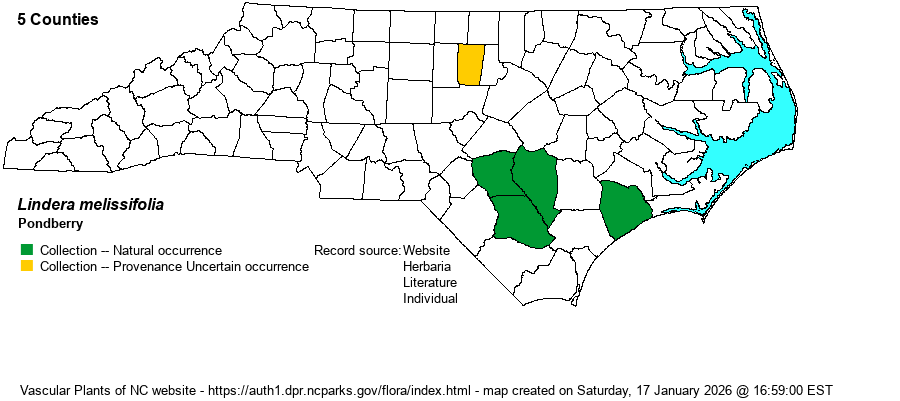| Author | (Walter) Blume | |
| Distribution | Currently, only in the southern Coastal Plain, known at present from Cumberland, Sampson, and Onslow counties, and formerly from Bladen County. Collections from Orange County, in the eastern Piedmont, in the 1820’s, are apparently correct, but are included on the map (below) as being "provenance uncertain". Known from only one or two sites in each county.
This is a very scarce Southern species with a somewhat disjunct range. It ranges from southern NC to GA and west to southeastern MO; it is not known from FL or TN.
| |
| Abundance | Very rare, but as it is quite colonial, it can occur in sizable numbers in a few of its known sites. This is a Federal and State Endangered species. | |
| Habitat | This species has strict habitat requirements – shallow seasonal pools and wet depressions. These pools may be in clay-based Carolina bays, but they can also be other types of pools, generally associated with pinelands and often with pocosin shrubs and a variety of wetland herbs. Plants typically grow in partial sun. They respond well to periodic fire, and fire suppression is a threat throughout its range. |
| Phenology | Blooms before leaves emerge, in March and April; fruits in August and September. | |
| Identification | This is a rather small and slender, lightly-branched deciduous shrub, growing about 3 feet tall, usually in colonies. The alternate leaves are oblong to narrowly elliptic, pointed at the tip and rounded at the base, averaging 4 inches long. The twigs have a fragrant odor when broken, though as this is an endangered species, breaking twigs is not recommended. For most of the growing season, the plants should be easily identified by its abundance of small yellow flowers in clusters along the bare branches, followed by the fleshy drupes that turn bright red in late summer and fall. As it occurs only at a few sites in the state, you will almost certainly not discover a population on your own and will need to visit a known site. | |
| Taxonomic Comments | The main comment is the fairly recent change in spelling of the scientific name, from L. melissaefolia to L. melissifolia.
| |
| Other Common Name(s) | Though it is best to name any Lindera taxon as “xxxxx Spicebush”, and several common names do this – Southern Spicebush and Hairy Spicebush, the fact that the U.S. Fish and Wildlife Service names it as Pondberry, as do quite a few other references, leans the best common name to Pondberry. Jove’s-fruit is another common name. | |
| State Rank | S1 | |
| Global Rank | G3 | |
| State Status | E | |
| US Status | LE | |
| USACE-agcp | FACW link |
| USACE-emp | OBL link |

